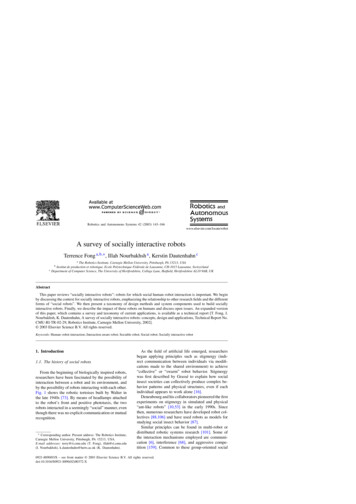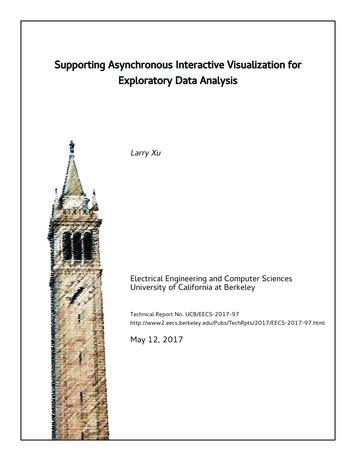
Transcription
Robotics and Autonomous Systems 42 (2003) 143–166A survey of socially interactive robotsTerrence Fong a,b, , Illah Nourbakhsh a , Kerstin Dautenhahn ca The Robotics Institute, Carnegie Mellon University, Pittsburgh, PA 15213, USAInstitut de production et robotique, Ecole Polytechnique Fédérale de Lausanne, CH-1015 Lausanne, SwitzerlandDepartment of Computer Science, The University of Hertfordshire, College Lane, Hatfield, Hertfordshire AL10 9AB, UKbcAbstractThis paper reviews “socially interactive robots”: robots for which social human–robot interaction is important. We beginby discussing the context for socially interactive robots, emphasizing the relationship to other research fields and the differentforms of “social robots”. We then present a taxonomy of design methods and system components used to build sociallyinteractive robots. Finally, we describe the impact of these robots on humans and discuss open issues. An expanded versionof this paper, which contains a survey and taxonomy of current applications, is available as a technical report [T. Fong, I.Nourbakhsh, K. Dautenhahn, A survey of socially interactive robots: concepts, design and applications, Technical Report No.CMU-RI-TR-02-29, Robotics Institute, Carnegie Mellon University, 2002]. 2003 Elsevier Science B.V. All rights reserved.Keywords: Human–robot interaction; Interaction aware robot; Sociable robot; Social robot; Socially interactive robot1. Introduction1.1. The history of social robotsFrom the beginning of biologically inspired robots,researchers have been fascinated by the possibility ofinteraction between a robot and its environment, andby the possibility of robots interacting with each other.Fig. 1 shows the robotic tortoises built by Walter inthe late 1940s [73]. By means of headlamps attachedto the robot’s front and positive phototaxis, the tworobots interacted in a seemingly “social” manner, eventhough there was no explicit communication or mutualrecognition. Corresponding author. Present address: The Robotics Institute,Carnegie Mellon University, Pittsburgh, PA 15213, USA.E-mail addresses: terry@ri.cmu.edu (T. Fong), illah@ri.cmu.edu(I. Nourbakhsh), k.dautenhahn@herts.ac.uk (K. Dautenhahn).As the field of artificial life emerged, researchersbegan applying principles such as stigmergy (indirect communication between individuals via modifications made to the shared environment) to achieve“collective” or “swarm” robot behavior. Stigmergywas first described by Grassé to explain how socialinsect societies can collectively produce complex behavior patterns and physical structures, even if eachindividual appears to work alone [16].Deneubourg and his collaborators pioneered the firstexperiments on stigmergy in simulated and physical“ant-like robots” [10,53] in the early 1990s. Sincethen, numerous researchers have developed robot collectives [88,106] and have used robots as models forstudying social insect behavior [87].Similar principles can be found in multi-robot ordistributed robotic systems research [101]. Some ofthe interaction mechanisms employed are communication [6], interference [68], and aggressive competition [159]. Common to these group-oriented social0921-8890/03/ – see front matter 2003 Elsevier Science B.V. All rights reserved.doi:10.1016/S0921-8890(02)00372-X
144T. Fong et al. / Robotics and Autonomous Systems 42 (2003) 143–166Fig. 3. Khepera robots foraging for “food” [87].Fig. 1. Precursors of social robotics: Walter’s tortoises, Elmer andElsie, “dancing” around each other.Fig. 4. Collective box-pushing [88].robots is maximizing benefit (e.g., task performance)through collective action (Figs. 2–4).The research described thus far uses principles ofself-organization and behavior inspired by social insect societies. Such societies are anonymous, homogeneous groups in which individuals do not matter.This type of “social behavior” has proven to be anattractive model for robotics, particularly because itenables groups of relatively simple robots performdifficult tasks (e.g., soccer playing).However, many species of mammals (including humans, birds, and other animals) often form individualized societies. Individualized societies differ fromanonymous societies because the individual matters.Although individuals may live in groups, they form relationships and social networks, they create alliances,and they often adhere to societal norms and conventions [38] (Fig. 5).In [44], Dautenhahn and Billard proposed the following definition:Social robots are embodied agents that are part ofa heterogeneous group: a society of robots or humans. They are able to recognize each other andengage in social interactions, they possess histories(perceive and interpret the world in terms of theirown experience), and they explicitly communicatewith and learn from each other.Developing such “individual social” robots requiresthe use of models and techniques different from “groupFig. 2. U-Bots sorting objects [106].Fig. 5. Early “individual” social robots: “getting to know eachother” (left) [38] and learning by imitation (right) [12,13].
T. Fong et al. / Robotics and Autonomous Systems 42 (2003) 143–166Fig. 6. Fields of major impact. Note that “collective robots” and“social robots” overlap where individuality plays a lesser role.social” collective robots (Fig. 6). In particular, sociallearning and imitation, gesture and natural languagecommunication, emotion, and recognition of interaction partners are all important factors. Moreover, mostresearch in this area has focused on the applicationof “benign” social behavior. Thus, social robots areusually designed as assistants, companions, or pets, inaddition to the more traditional role of servants.1.2. Social robots and social embeddedness:concepts and definitionsRobots in individualized societies exhibit a widerange of social behavior, regardless if the society contains other social robots, humans, or both. In [19],Breazeal defines four classes of social robots in termsof: (1) how well the robot can support the social modelthat is ascribed to it and (2) the complexity of the interaction scenario that can be supported as follows.Socially evocative. Robots that rely on the humantendency to anthropomorphize and capitalize on feelings evoked when humans nurture, care, or involvedwith their “creation”.Social interface. Robots that provide a “natural”interface by employing human-like social cues andcommunication modalities. Social behavior is onlymodeled at the interface, which usually results in shallow models of social cognition.Socially receptive. Robots that are socially passivebut that can benefit from interaction (e.g. learningskills by imitation). Deeper models of human social145competencies are required than with social interfacerobots.Sociable. Robots that pro-actively engage with humans in order to satisfy internal social aims (drives,emotions, etc.). These robots require deep models ofsocial cognition.Complementary to this list we can add the followingthree classes:Socially situated. Robots that are surrounded by asocial environment that they perceive and react to [48].Socially situated robots must be able to distinguishbetween other social agents and various objects in theenvironment.1Socially embedded. Robots that are: (a) situated ina social environment and interact with other agentsand humans; (b) structurally coupled with their socialenvironment; and (c) at least partially aware of humaninteractional structures (e.g., turn-taking) [48].Socially intelligent. Robots that show aspects of human style social intelligence, based on deep modelsof human cognition and social competence [38,40].1.3. Socially interactive robotsFor the purposes of this paper, we use the term “socially interactive robots” to describe robots for whichsocial interaction plays a key role. We do this, not tointroduce another class of social robot, but rather todistinguish these robots from other robots that involve“conventional” human–robot interaction, such as thoseused in teleoperation scenarios.In this paper, we focus on peer-to-peer human–robotinteraction. Specifically, we describe robots that exhibit the following “human social” characteristics: express and/or perceive emotions;communicate with high-level dialogue;learn/recognize models of other agents;establish/maintain social relationships;use natural cues (gaze, gestures, etc.);exhibit distinctive personality and character;may learn/develop social competencies.Socially interactive robots can be used for a variety of purposes: as research platforms, as toys, as educational tools, or as therapeutic aids. The common,1Other researchers place different emphasis on what sociallysituated implies (e.g., [97]).
146T. Fong et al. / Robotics and Autonomous Systems 42 (2003) 143–166underlying assumption is that humans prefer to interact with machines in the same way that they interactwith other people. A survey and taxonomy of currentapplications is given in [60].Socially interactive robots operate as partners, peersor assistants, which means that they need to exhibit acertain degree of adaptability and flexibility to drivethe interaction with a wide range of humans. Sociallyinteractive robots can have different shapes and functions, ranging from robots whose sole purpose andonly task is to engage people in social interactions(Kismet, Cog, etc.) to robots that are engineered toadhere to social norms in order to fulfill a range oftasks in human-inhabited environments (Pearl, Sage,etc.) [18,117,127,140].Some socially interactive robots use deep modelsof human interaction and pro-actively encourage social interaction. Others show their social competenceonly in reaction to human behavior, relying on humansto attribute mental states and emotions to the robot[39,45,55,125]. Regardless of function, building a socially interactive robot requires considering the humanin the loop: as designer, as observer, and as interactionpartner.1.4. Why socially interactive robots?Socially interactive robots are important for domains in which robots must exhibit peer-to-peer interaction skills, either because such skills are requiredfor solving specific tasks, or because the primary function of the robot is to interact socially with people. Adiscussion of application domains, design spaces, anddesirable social skills for robots is given in [42,43].One area where social interaction is desirable isthat of “robot as persuasive machine” [58], i.e., therobot is used to change the behavior, feelings or attitudes of humans. This is the case when robots mediatehuman–human interaction, as in autism therapy [162].Another area is “robot as avatar” [123], in which therobot functions as a representation of, or representative for, the human. For example, if a robot is used forremote communication, it may need to act socially inorder to effectively convey information.In certain scenarios, it may be desirable for a robotto develop its interaction skills over time. For example, a pet robot that accompanies a child through hischildhood may need to improve its skills in order tomaintain the child’s interest. Learned development ofsocial (and other) skills is a primary concern of epigenetic robotics [44,169].Some researchers design socially interactive robotssimply to study embodied models of social behavior. For this use, the challenge is to build robots thathave an intrinsic notion of sociality, that develop socialskills and bond with people, and that can show empathy and true understanding. At present, such robots remain a distant goal [39,44], the achievement of whichwill require contributions from other research areassuch as artificial life, developmental psychology andsociology [133].Although socially interactive robots have alreadybeen used with success, much work remains to increase their effectiveness. For example, in order forsocially interactive robots to be accepted as “natural”interaction partners, they need more sophisticated social skills, such as the ability to recognize social context and convention.Additionally, socially interactive robots will eventually need to support a wide range of users: different genders, different cultural and social backgrounds,different ages, etc. In many current applications, social robots engage only in short-term interaction (e.g.,a museum tour) and can afford to treat all humans inthe same manner. But, as soon as a robot becomes partof a person’s life, that robot will need to be able totreat him as a distinct individual [40].In the following, we closely examine the conceptsraised in this introductory section. We begin by describing different design methods. Then, we present ataxonomy of system components, focusing on the design issues unique to socially interactive robots. Weconclude by discussing open issues and core challenges.2. Methodology2.1. Design approachesHumans are experts in social interaction. Thus,if technology adheres to human social expectations,people will find the interaction enjoyable, feelingempowered and competent [130]. Many researchers,therefore, explore the design space of anthropomorphic (or zoomorphic) robots, trying to endow their
T. Fong et al. / Robotics and Autonomous Systems 42 (2003) 143–166creations with characteristics of intentional agents. Forthis reason, more and more robots are being equippedwith faces, speech recognition, lip-reading skills,and other features and capacities that make robot–human interaction “human-like” or at least “creaturelike” [41,48].From a design perspective, we can classify how socially interactive robots are built in two primary ways.With the first approach, “biologically inspired”, designers try to create robots that internally simulate, ormimic, the social intelligence found in living creatures.With the second approach, “functionally designed”,the goal is to construct a robot that appears outwardlyto be socially intelligent, even if the internal designdoes not have a basis in science.Robots have limited perceptual, cognitive, and behavioral abilities compared to humans. Thus, for theforeseeable future, there will continue to be significantimbalance in social sophistication between human androbot [20]. As with expert systems, however, it is possible that robots may become highly sophisticated inrestricted areas of socialization, e.g., infant-caretakerrelations.Finally, differences in design methodology meansthat the evaluation and success criteria are almost always different for different robots. Thus, it is hardto compare socially interactive robots outside of theirtarget environment and use.2.1.1. Biologically inspiredWith the “biologically inspired” approach, designers try to create robots that internally simulate, ormimic, the social behavior or intelligence found in living creatures. Biologically inspired designs are basedon theories drawn from natural and social sciences,including anthropology, cognitive science, developmental psychology, ethology, sociology, structure ofinteraction, and theory of mind. Generally speaking,these theories are used to guide the design of robotcognitive, behavioral, motivational (drives and emotions), motor and perceptual systems.Two primary arguments are made for drawing inspiration from biological systems. First, numerousresearchers contend that nature is the best model for“life-like” activity. The hypothesis is that in order fora robot to be understandable by humans, it must havea naturalistic embodiment, it must interact with itsenvironment in the same way living creatures do, and147it must perceive the same things that humans find tobe salient and relevant [169].The second rationale for biological inspiration isthat it allows us to directly examine, test and refinethose scientific theories upon which the design is based[1]. This is particularly true with humanoid robots.Cog, for example, is a general-purpose humanoid platform intended for exploring theories and models ofintelligent behavior and learning [140].Some of the theories commonly used in biologicallyinspired design are as follows.Ethology. This refers to the observational studyof animals in their natural setting [95]. Ethologycan serve as a basis for design because it describesthe types of activity (comfort-seeking, play, etc.) arobot needs to exhibit in order to appear life-like[4]. Ethology is also useful for addressing a range ofbehavioral issues such as concurrency, motivation, andinstinct.Structure of interaction. Analysis of interactionalstructure (such as instruction, cooperation, etc.) canhelp focus design of perception and cognition systemsby identifying key interaction patterns [162]. Dautenhahn, Ogden and Quick use explicit representationsof interactional structure to design “interaction aware”robots [48]. Dialogue models, such as turn-taking inconversation, can also be used in design as in [104].Theory of mind. Theory of mind refers to thosesocial skills that allow humans to correctly attributebeliefs, goals, perceptions, feelings, and desires tothemselves and others [163]. One of the critical precursors to these skills is joint (or shared) attention:the ability to selectively attend to an object of mutualinterest [7]. Joint attention can aid design, by providing guidelines for recognizing and producing socialbehaviors such as gaze direction, pointing gestures,etc. [23,140].Developmental psychology. Developmental psychology has been cited as an effective mechanismfor creating robots that engage in natural social exchanges. As an example, the design of Kismet’s“synthetic nervous system”, particularly the perceptual and behavioral aspects, is heavily inspired by thesocial development of human infants [18]. Additionally, theories of child cognitive development, such asVygotsky’s “child in society” [92], can offer a framework for constructing robot architecture and socialinteraction design [44].
148T. Fong et al. / Robotics and Autonomous Systems 42 (2003) 143–1662.1.2. Functionally designedWith the “functionally designed” approach, the objective is to design a robot that outwardly appears tobe socially intelligent, even if the internal design doesnot have a basis in science or nature. This approachassumes that if we want to create the impression of anartificial social agent driven by beliefs and desires, wedo not necessarily need to understand how the mindreally works. Instead, it is sufficient to describe themechanisms (sensations, traits, folk-psychology, etc.)by which people in everyday life understand sociallyintelligent creatures [125].In contrast to their biologically inspired counterparts, functionally designed robots generally haveconstrained operational and performance objectives.Consequently, these “engineered” robots may needonly to generate certain effects and experiences withthe user, rather than having to withstand deep scrutinyfor “life-like” capabilities.Some motivations for “functional design” are: The robot may only need to be superficially socially competent. This is particularly true when onlyshort-term interaction or limited quality of interaction is required. The robot may have limited embodiment, capabilityfor interaction, or may be constrained by the environment. Even limited social expression can help improvethe affordances and usability of a robot. In someapplications, recorded or scripted speech may besufficient for human–robot dialogue. Artificial designs can provide compelling interaction. Many video games and electronic toys fullyengage and occupy attention, even if the artifactsdo not have real-world counterparts.The three techniques most often used in functionaldesign are as follows.Human–computer interaction (HCI) design. Robotsare increasingly being developed using HCI techniques, including cognitive modeling, contextualinquiry, heuristic evaluation, and empirical user testing [115]. Scheeff et al. [142], for example, describerobot development based on heuristic design.Systems engineering. Systems engineering involvesthe development of functional requirements to facilitate development and operation [135]. A basic charac-teristic of system engineering is that it emphasizes thedesign of critical-path elements. Pineau et al. [127],for example, describe mobile robots that assist the elderly. Because these robots operate in a highly structured domain, their design centers on specific taskbehaviors (e.g., navigation).Iterative design. Iterative (or sequential) design, isthe process of revising a design through a series oftest and redesign cycles [147]. It is typically usedto address design failures or to make improvementsbased on information from evaluation or use. Willekeet al. [164], for example, describe a series of museumrobots, each of which was designed based on lessonslearned from preceding generations.2.2. Design issuesAll robot systems, whether socially interactive ornot, must solve a number of common design problems.These include cognition (planning, decision making),perception (navigation, environment sensing), action(mobility, manipulation), human–robot interaction(user interface, input devices, feedback display) andarchitecture (control, electromechanical, system). Socially interactive robots, however, must also addressthose issues imposed by social interaction [18,40].Human-oriented perception. A socially interactiverobot must proficiently perceive and interpret humanactivity and behavior. This includes detecting and recognizing gestures, monitoring and classifying activity,discerning intent and social cues, and measuring thehuman’s feedback.Natural human–robot interaction. Humans androbots should communicate as peers who know eachother well, such as musicians playing a duet [145].To achieve this, the robot must manifest believablebehavior: it must establish appropriate social expectations, it must regulate social interaction (usingdialogue and action), and it must follow social convention and norms.Readable social cues. A socially interactive robotmust send signals to the human in order to: (1) provide feedback of its internal state; (2) allow human tointeract in a facile, transparent manner. Channels foremotional expression include facial expression, bodyand pointer gesturing, and vocalization.Real-time performance. Socially interactive robotsmust operate at human interaction rates. Thus, a robot
T. Fong et al. / Robotics and Autonomous Systems 42 (2003) 143–166149needs to simultaneously exhibit competent behavior,convey attention and intentionality, and handle socialinteraction.In the following sections, we review design issuesthat are unique to socially interactive robots. Althoughwe do not discuss every aspect of design, we feel thataddressing each of the following is critical to buildingan effective social robot.2.3. EmbodimentWe define embodiment as “that which establishesa basis for structural coupling by creating the potential for mutual perturbation between system andenvironment” [48]. Thus, embodiment is grounded inthe relationship between a system and its environment. The more a robot can perturb an environment,and be perturbed by it, the more it is embodied. Thisalso means that social robots do not necessarily needa physical body. For example, conversational agents[33] might be embodied to the same extent as robotswith limited actuation.An important benefit of this “relational definition”is that it provides an opportunity to quantify embodiment. For example, one might measure embodimentin terms of the complexity of the relationship betweenrobot and environment over all possible interactions(i.e., all perturbatory channels).Some robots are clearly more embodied than others[48]. Consider the difference between Aibo (Sony)and Khepera (K-Team), as shown in Fig. 7. Aibohas approximately 20 actuators (joints across mouth,heads, ears, tails, and legs) and a variety of sensors(touch, sound, vision and proprioceptive). In contrast, Khepera has two actuators (independent wheelcontrol) and an array of infrared proximity sensors.Because Aibo has more perturbatory channels andbandwidth at its disposal than does Khepera, it canbe considered to be more strongly embodied thanKhepera.2.3.1. MorphologyThe form and structure of a robot is important because it helps establish social expectations. Physicalappearance biases interaction. A robot that resemblesa dog will be treated differently (at least initially) thanone which is anthropomorphic. Moreover, the relativefamiliarity (or strangeness) of a robot’s morphologyFig. 7. Sony Aibo ERS-110 (top) and K-Team Khepera (bottom).can have profound effects on its accessibility, desirability, and expressiveness.The choice of a given form may also constrain thehuman’s ability to interact with the robot. For example, Kismet has a highly expressive face. But becauseit is designed as a head, Kismet is unable to interact when touch (e.g., manipulation) or displacement(self-movement) is required.To date, most research in human–robot interactionhas not explicitly focused on design, at least not in thetraditional sense of industrial design. Although knowledge from other areas of design (including product,interaction and stylized design) can inform robot construction, much research remains to be performed.2.3.2. Design considerationsA robot’s morphology must match its intended function [54]. If a robot is designed to perform tasks forthe human, then its form must convey an amount of“product-ness” so that the user will feel comfortable
150T. Fong et al. / Robotics and Autonomous Systems 42 (2003) 143–166Fig. 8. Mori’s “uncanny valley” (from DiSalvo et al. [54]).using the robot. Similarly, if peer interaction is important, the robot must project an amount of “humanness”so that the user will feel comfortable in socially engaging the robot.At the same time, however, a robot’s design needsto reflect an amount of “robot-ness”. This is neededso that the user does not develop detrimentally falseexpectations of the robot’s capabilities [55].Finally, if a robot needs to portray a living creature,it is critical that an appropriate degree of familiaritybe maintained. Mashiro Mori contends that the progression from a non-realistic to realistic portrayal ofa living thing is non-linear. In particular, there is an“uncanny valley” (see Fig. 8) as similarity becomesalmost, but not quite perfect. At this point, the subtleimperfections of the recreation become highly disturbing, or even repulsive [131]. Consequently, caricaturedrepresentations may be more useful, or effective, thanmore complex, “realistic” representations.We classify social robots as being embodied in fourbroad categories: anthropomorphic, zoomorphic, caricatured, and functional.2.3.3. AnthropomorphicAnthropomorphism, from the Greek “anthropos”for man and “morphe” for form/structure, is the tendency to attribute human characteristics to objects witha view to helping rationalize their actions [55]. Anthropomorphic paradigms have widely been used toaugment the functional and behavioral characteristicsof social robots.Having a naturalistic embodiment is often citedas necessary for meaningful social interaction[18,82,140]. In part, the argument is that for a robotto interact with humans as humans do (through gaze,gesture, etc.), then it must be structurally and functionally similar to a human. Moreover, if a robot is to learnfrom humans (e.g., through imitation), then it shouldbe capable of behaving similarly to humans [11].The role of anthropomorphism is to function as amechanism through which social interaction can befacilitated. Thus, the ideal use of anthropomorphismis to present an appropriate balance of illusion (to leadthe user to believe that the robot is sophisticated inareas where the user will not encounter its failings)and functionality (to provide capabilities necessary forsupporting human-like interaction) [54,79].2.3.4. ZoomorphicAn increasing number of entertainment, personal,and toy robots have been designed to imitate livingcreatures. For these robots, a zoomorphic embodimentis important for establishing human–creature relationships (e.g., owner-pet). The most common designs areinspired by household animals, such as dogs (SonyAibo and RoboScience RoboDog) and cats (Omron),with the objective of creating robotic “companions”.Avoiding the “uncanny valley” may be easier withzoomorphic design because human–creature relationships are simpler than human–human relationshipsand because our expectations of what constitutes“realistic” animal morphology tends to be lower.2.3.5. CaricaturedAnimators have long shown that a character doesnot have to appear realistic in order to be believable[156]. Moreover, caricature can be used to create desired interaction biases (e.g., implied abilities) and tofocus attention on, or distract attention from, specificrobot features.Scheeff et al. [142] discusses how techniques fromtraditional animation can be used in social robot design. Schulte et al. [143] describe how a caricaturedhuman face can provide a “focal point” for attention.Similarly, Severinson-Eklund et al. [144] describe theuse of a small mechanical character, CERO, as a robot“representative” (see Fig. 9).2.3.6. FunctionalSome researchers argue that a robot’s embodimentshould first, and foremost, reflect the tasks it mustperform. The choice and design of physical features isthus guided purely by operational objectives. This type
T. Fong et al. / Robotics and Autonomous Systems 42 (2003) 143–166151In recent years, emotion has increasingly been usedin interface and robot design, primarily because of therecognition that people tend to treat computers as theytreat other people [31,33,121,130]. Moreover, manystudies have been performed to integrate emotions intoproducts including electronic games, toys, and software agents [8].Fig. 9. CERO (KTH).of embodiment appears most often with functionallydesigned robots, especially service robots.Health care robots, for example, may be required toassist elderly, or disabled, patients in moving about.Thus, features
Robotics and Autonomous Systems 42 (2003) 143-166 A survey of socially interactive robots Terrence Fonga,b, , Illah Nourbakhsha, Kerstin Dautenhahnc a The Robotics Institute, Carnegie Mellon University, Pittsburgh, PA 15213, USA b Institut de production et robotique, Ecole Polytechnique Fédérale de Lausanne, CH-1015 Lausanne, Switzerland c Department of Computer Science, The University .










